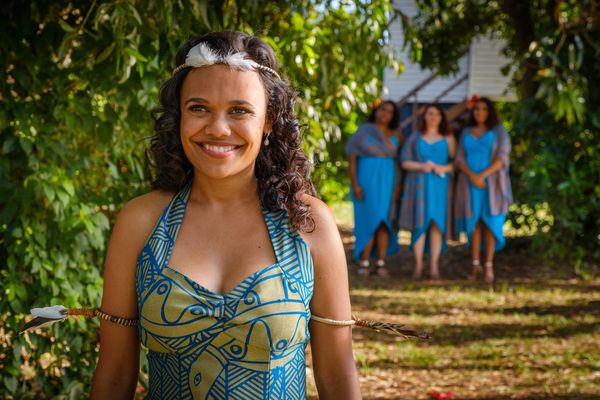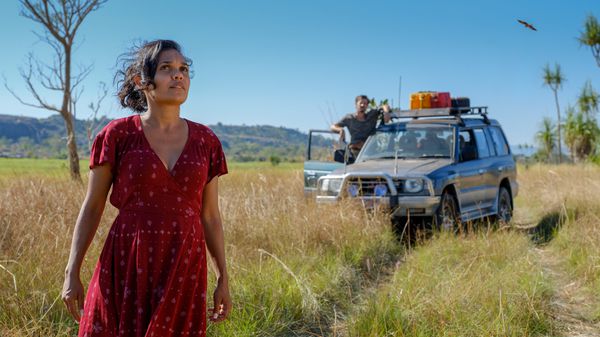At Sundance, we caught up with Blair, Tapsell, Lee and Tyler to talk about making the film, which Tapsell describes as “a love letter to the Territory and the people in it”. The cast and crew worked with the traditional owners and indigenous people of everywhere that they filmed and Tapsell says they were all grateful for the support.
Talking about her specific dedication at the end of the film, Tapsell says: “This beautiful woman was my grandmother’s sister. My grandmother lived in Darwin but her sister lived on the Tiwi Islands and when I met her, she gave me this big pinch on the cheek and said, ‘You have to call me Nana.’ And she was the bridge into the community for me, since I hadn’t grown up with that community and on that country. She didn’t live to see the film and that’s why I dedicated it to her.”
The road trip in the film leads to the Tiwi Islands and features many people from the local community as extras.
“Those women were significant,” adds Tapsell, “because not only do they sing in a choir, a lot of them are very passionate about continuing the language and continuing the stories that their ancestors have passed on, so it was incredibly important to have them in the film.”
While Tapsell was going to a place she was at least familiar with, the trip north was all new to British actor Lee, who says he felt “incredibly privileged” to get the part.
He adds: “I’ve been to Australia before but never to Northern Territory. I knew a bit about Aboriginal culture and history but I didn’t know enough, so I tried to learn as much as I could while I was out there. We were really embraced by the communities we visited. We went into parts of the country that no one else gets access to, because you had all spent such a long time to establish good and respectful relationships with these owners of these lands.
 |
| Miranda Tapsell, pictured as Lauren: 'The places we visited forced you to be present. I think that’s another part of the film that’s so universal' Photo: Courtesy of Sundance Film Festival |
“They gave us the privilege of going into parts of the country that no one gets to see. So, that was amazing. But it made the acting quite easy, because I’m playing the awe of a character who has never been to these places and it was the same for me, so I really didn’t have to do much.”
There was a lot of collaboration involved in the film, not just with the communities, but on the script itself.
Tyler says: “I guess, it was a true collaboration in that we were both really just throwing ideas back and forth and rewriting each other’s scenes and, like Gwylim, I had a lot to learn about indigenous culture as well. Because we collaborated it’s got an authenticity to it that it wouldn’t have otherwise.
“It did get a little bit deeper, I think, once we started working with Wayne and the conversations we had. We just went a bit deeper into the emotional aspect of the third act. But we always liked the idea. I think if you can make people laugh, they’re more open to being emotional and being moved by things later on in the story, so that was always part of the structure but we went a bit deeper.
Blair adds: “To be specific, there was a time when the mother came back and her parents weren’t even alive. The story point of that did evolve.”
So, does it make a difference to the script, when you’re going to be the one delivering the lines onscreen at the end of it?
Tapsell says: “I think I was so focused on how to tell the story, that all of a sudden I got there and it was rehearsals and we were about to film and I was like, ‘Oh yeah, I’ve actually got to step out of this and get into the skin now.’ So that was certainly a challenge. It’s my first time writing something, I have acted before – but it was definitely a learning curve, putting on one hat and taking off the other.”
“It was great,” adds Lee “because Miranda did a really good job of leaving her writer’s hat at home when she came on to set every day and just concentrating on her job of playing Lauren. But you also knew that when it came down to it, you have also got an expert here that you can tap for any question that you have.
“There were scenes, like in rehearsals and the lead up to shooting, where we were trying to clarify and tighten and refocus and to have Miranda in the room when we were rehearsing and to have Josh on hand as well was great. You’re not having to deal with writing by committee or dealing with huge studio politics, you can just make decisions between you on set.”
If You Leave Me Now, by Chicago – which Lee describes as “an absolute tune!” – plays a key comedy role in the film and Tyler says it’s his wife who is the fan of the band.
He adds: “We looked at other options – it was always that song – and the producers got on to it pretty early. Chicago and the Janet Jackson song Escapade were first on the list.”
There’s also a rich seam of visual humour in the film, from recreating the spaghetti scene from Lady And The Tramp to a full-on hen party “penis cake”.
Lee says: “The production designer, who was designing the penis cake was having a very serious discussion with Wayne. ‘Now do you want semen? How big should the balls be?’ These were the serious conversations.
Tapsell adds: “I just remember, when Josh and I were talking about it, we both said, ‘We’re such children!’” As for that spaghetti scene – which sees Ned take on the role of Tramp – alongside Lauren’s pet dog Cher (played by Flea and Skye), Lee explained how they recreated it.
“I got very intimate with those dogs,” he says. “But that’s just the way I like to work. That was for real. I think it was string. We had this amazing animal handler, who is just used to being with animals the whole time and having pockets full of chicken to give to them. And she would just come up to me and forget that I’m not an animal handler and just rub chicken on my face and say, ‘There you go, he’ll lick you now’. I was like, ‘That’s disgusting’.”
Blair adds: “There was also a dog there just to urinate on the bus stop. That was his only job. He’d done Legally Blonde – the musical.”
The dogs might have been cute but the cast and crew also had to deal with the possibility of some less adorable animals making their presence felt.
Lee says the shoot was “pretty intimidating”. He adds: “Every day on the course, you’d see the croc spotter or snake charmer – well, not charmer, but snake-wrangler.
Tyler chips in: “We had a security guard protecting people from walking under coconut trees as well.”
Lee, who is never one to let a punchline go by, adds: “There’s no limit to the dangers out there but the whole thing was like an adventure. It was quite a small crew that all worked so hard and were so invested in telling the story. We travelled great distances and filmed in the middle of nowhere at times. There was so much camaraderie as a result, it was a real team effort. So many in the crew hadn’t been to the Northern Territory either, so there was this sense of discovery for everyone concerned, which added to this excited energy of making this film.”
The laughs come thick and fast in the film but there is also a more melancholy element, about keeping in touch with your cultural heritage and about ageing – with one character suffering memory loss.
Tapsell says : “What I love about the Territory and why I often return is that I think it’s nice to just be able to be in a space where there’s just no sound. We were travelling to some really off the beaten track places, which means there are snakes about, you could fall from a rock so you had to be mindful where you stepped. The places we visited forced you to be present. I think that’s another part of the film that’s so universal.
“I think Lauren can get worried about so many different things and the Territory is telling her, ‘No, just stop and think about what is important.’ It is very understated that kind of message, but I think I’m really proud that when I watch it that came across. With the way that everyone interacts when they read the news and the way that they talk about it on social media, it can just be noise sometimes. I can see its value but I can also see how people just get caught up in distraction and I think it’s really nice to show off a country that teaches you how to de-clutter.”
Blair adds: “I think we can lose sight of having that connection to home. I think that was one of the things that I responded to in this story. And the inherent stories that we sort of grew up on, like The Wizard of Oz, Citizen Kane through to bloody ET. Now we know there’s an importance about family, community and home and I think Top End Wedding does it really well.”
Tapsell says: “I can’t really think of a film like Top End Wedding in Australia, so it’s really hard to try to talk about a community and everything that comes with that and be honest and authentic about it but within a 90-minute film when you don’t have something to reference. Because, while I love all the films that have wedding in the title, they don’t have a Lauren. So I go, ‘Well, how is Lauren different to When Harry Met Sally’s Sally Albright, how is Ned different to Tom Hanks’ character in Sleepless In Seattle. What’s their world like and how are they influenced by it?
“We were always trying to figure out who Ned was. When we were writing it, Josh and I, there needed to be a Luke Skywalker character.”
Lee asks: “Is that me? Am I Luke Skywalker? Awesome.”
As for what’s next, Tyler and Tapsell are continuing to collaborate.
Tyler says: “We’ve written a kids book and we’ve got some TV ideas.”
Lee suggests: “Top End Honeymoon, Top End First Child, Top End Divorce…”
Top End Wedding is due for release in Australia in May.























